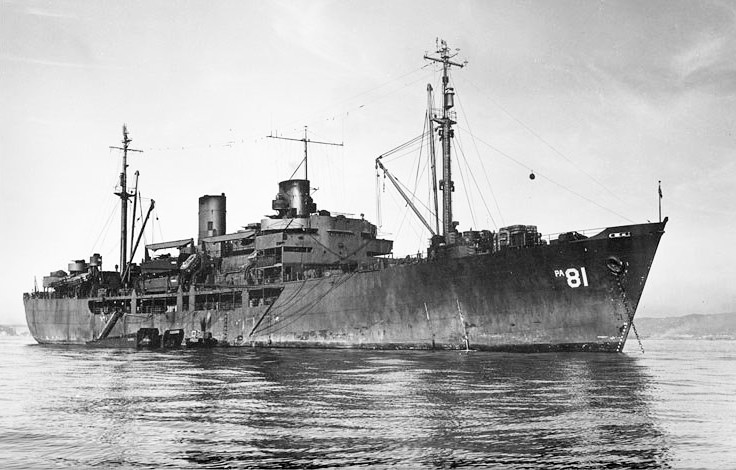

Gilliam-class attack transport

The Gilliam-class attack transport was a class of attack transport built for service with the US Navy in World War II.
Like all attack transports, the purpose of the Gilliams was to transport troops and their equipment to foreign shores in order to execute amphibious invasions using an array of smaller amphibious assault boats carried by the attack transport itself. Like all the attack transports, the Gilliam-class was heavily armed with antiaircraft weaponry to protect itself and its cargo of troops from air attack in the battle zone.
Class History
The Gilliam-class utilized the Maritime Commission (MARCOM)'s Type S4-SE2-BD1 hull. All 32 vessels of the class were built under MARCOM contracts by the Consolidated Steel Corporation of Wilmington, California.
The first of the ships, the USS Gilliam (APA-57), rolled off the Wilmington ways on 28 March 1944 and was commissioned on 1 August 1944. The rest rapidly followed, a new Gilliam-class vessel rolling of the shipways at an average of roughly one per week until April 1945.
The Gilliams, with less than half the displacement, were significantly inferior in both troop and cargo carrying capacity to the previous class of attack transport, the Bayfields, and also slightly slower. It is not clear therefore why they were produced but probably it was simply because attack transports were at this time a much-needed type and the Navy chose to utilize any available shipbuilding capacity to acquire them.
Service
As they arrived relatively late in the war, Gilliam-class ships did not get much chance to see combat. Some of the earlier vessels saw action at either the battle of Luzon or the battle of Iwo Jima and later at the invasion of Okinawa, while later vessels saw combat either at Okinawa alone or not at all. Regardless, all of them spent a considerable part of their time on troop transport, cargo and other support missions.
In the immediate postwar period, the Gilliams, like most other classes of attack transport, were initially utilized to transport US troops for occupation duties - in Japan, China, Korea and other Far Eastern locations formerly occupied by the Imperial Japanese Army - and later as participants in Operation Magic Carpet, the giant sealift organized to bring hundreds of thousands of demobilizing soldiers back to the United States.
At the end of the war, the US Navy found itself with far more ships than it required in peacetime. Some of these ships were dispensed with in Operation Crossroads, the atomic bomb tests at Bikini Atoll in the summer of 1946. These tests were designed to assess the effects of nuclear detonations on shipping.
For the purpose, the Navy collected somewhere between 70 and 90 unwanted ships to use as targets, some captured from the enemy and some of the Navy's own. Since the Gilliam-class had an inferior transport and cargo capacity to many of the other attack transport classes, it was an obvious candidate for disposal.
17 of the Gilliam-class were duly selected to act as targets in the tests. In the event, one - USS Appling (APA-58) - was reprieved, so exactly half of the class' 32 ships were designated as targets. Of these, a few were sunk by the atomic bombs themselves, while a number of others which received heavy doses of radiation were examined for a period before being disposed of in target practice in 1947 or 1948. A few were found to have mostly escaped the radioactive fallout and were taken back to the United States.
These survivors, along with the rest of the class, were decommissioned in late 1946-early 1947 and saw no further service with the Navy (although it is unknown whether some may have been later sold for commercial service). The sole exception was the USS Burleson (APA-67), which although decommissioned along with the remainder of the class, remained in use with the Navy as a training ship until 1 September 1968.
Other than this one vessel, it appears the entire class of ships saw barely more than two years service of any description before being scrapped.
Source: Wikipedia

USS Fallon (APA-81), one of 32 Gilliam-class attack transports
Name:
Builders:
Operator:
Proceeded by:
Succeeded by:
In commission:
Completed:
Gilliam class
Consolidated Steel
United States Navy
Sumter class
Haskell class
1 Aug 1944 - 9 Apr 1945 - 9 Apr 1946 - 23 Jan 1947
32
Class and type:
Displacement:
Length:
Beam:
Draft:
Propulsion:
Speed:
Capacity:
Complement:
Armament:
Notes:
Gilliam class attack transport
4,247 tons (lt) 7,080 t.(fl)
426 ft (130 m)
58 ft (18 m)
16 ft (4.9 m)
Westinghouse turbo-electric transmission, 2 boilers, twin propellers, Design shaft horsepower 6,000
17 knots (31 km/h; 20 mph)
47 Officers, 802 Enlisted,
Cargo: 85,000 cu ft, 600-2,600 tons
27 Officers, 295 Enlisted
1 × 5"/38 caliber dual-purpose gun mount, 4 × twin 40 mm gun mounts, 10 × single 20 mm gun mounts
Type S4-SE2-BD1 hull
Appling
Audrain
Banner
Barrow
Berrien
Bladen
Bracken
Briscoe
Brule
Burleson
Butte
Carlisle
Carteret
Catron
Clarendon
Cleburne
Colusa
Cortland
Crenshaw
Crittenden
Cullman
Dawson
Elkhart
Fallon
Fergus
Fillmore
Garrard
Gasconade
Geneva
Gilliam
Niagara
Presidio


